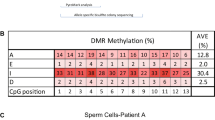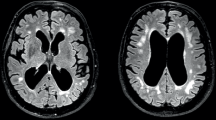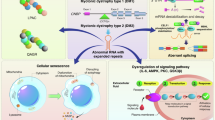Abstract
Myotonic dystrophy 1 (DM1) is known to diminish reproductive fitness in its severe form. Since no de novo mutations are known for this disease, it has the tendency to become extinct from a population. To explain the preservation of DM1 in a population, a hypothesis that a pool of subjects for the mutated gene exists in the apparently healthy (non-DM1) population was tested. In order to determine the (CTG) repeat number, PCR was performed in 274 patients found to have primary cataract of adult onset who showed no DM1 symptoms, and were not related to DM1 patients. In four cataract patients (1.46%; 95% CI 0.5–3.7), a protomutation in the myotonin protein kinase gene was found which might lead to a complete mutation after transmission through the next generations. The number of (CTG) repeats in the remaining 270 cataract patients did not differ significantly from the control subjects in terms of the distribution of larger [(CTG)n ≥ 19] versus smaller [(CTG)n < 19] alleles. We consider the primary cataract patients to be the pool of DMPK protomutation from which DM1 mutation is maintained in the population.
Similar content being viewed by others
Log in or create a free account to read this content
Gain free access to this article, as well as selected content from this journal and more on nature.com
or
References
Abbruzzese C, Costanzi Porrini S, Mariani B, Gould FK, Mcabney JP, Monckton DG, Ashizawa T, Giacanelli M (2002) Instability of a premutation allele in homozygous patients with myotonic dystrophy type 1. Ann Neurol 52:435–441
Aves SJ, Tongue N, Findlay KLG, Rich WJCC, West SP (1997) CTG trinucleotide repeat lengths in myotonic dystrophy alleles of patients with senile cataracts. Hum Mutat 9:95–96
Barcelo JM, Mahadevan M, Tsilfidis C, MacKenzie A, Korneluk R (1993) Intergenerational stability of the myotonic dystrophy protomutation. Hum Mol Genet 2:705–709
Boucher CA, King SK, Carey N, Krahe R, Winchester CL, Rahman S, Creavin T, Meghji P, Bailey ME, Chartier FL (1995) A novel homeodomain-encoding gene is associated with a large CpG island interrupted by the myotonic dystrophy unstable (CTG)n repeat. Hum Mol Genet 4:1919–1925
Brook JD, McCurrach ME, Harley HG, Buckler AJ, Church D, Aburatani H, Hunter K, Stanton VP, Thirion JP, Hudson T, Sohn R, Zemelman B, Snell RG, Rundle SA, Crow S, Davies J, Shelbourne P, Buxton J, Jones C, Juvonen V, Johnson K, Harper PS, Shaw DJ, Housman DE (1992) Molecular basis of myotonic dystrophy: expansion of a trinucleotide (CTG) repeat at the 3′ end of a transcript encoding a protein kinase family member. Cell 68:799–808
Brunner HG, Nillesen W, van Oost BA, Jansen G, Wieringa B (1992) Presymptomatic diagnosis of myotonic dystrophy. J Med Genet 29:780–784
Cobo AM, Poza JJ, Blanco A, Lopez de Munain A, Saenz A, Azpitarte M, Marchessi J, Marti masso JF (1996) Frequency of myotonic dystrophy gene carriers in cataract patients. J Med Genet 33:221–223
Davies J, Yamagata H, Shelbourne P, Buxton J, Ogihara T, Nokelainen P, Nakagawa M, Williamson R, Johnson K, Miki T (1992) Comparison of the myotonic dystrophy associated CTG repeat in European and Japanese population. J Med Genet 29:766–769
De Temmerman N, Sermon K, Seneca S, De Rycke M, Hilven P, Lissens W, Van Steirteghem A, Liebaers I. (2004) Intergenerational instability of the expanded CTG repeat in the DMPK gene: studies in human gametes and preimplantation embryos. Am J Hum Genet 75:325–329
Deka R, Majumder PP, Shriver MD, Stivers DN, Zhong Y, Yu LM; Barrantes R, Yin SJ; Miki T, Hundrieser J, Bunker CH, McGarvey ST, Sakallah S, Ferrel RE, Chakraborty R (1996) Distribution and evolution of CTG repeats at the myotonin protein kinase gene in human populations. Genome Res 6:142–154
Emery AE (1991) Population frequencies of inherited neuromuscular diseases—a world survey. Neuromuscul Disord 1:19–29
Goldman A, Ramsay M, Jenkins T (1995) New founder haplotypes at the myotonic dystrophy locus in southern Africa. Am J Hum Genet 56:1373–1378
Harley HG, Brook JD, Floyd J, Rundle SA, Crow S, Walsh KV, Thibault M-C, Harper PS, Shaw D J (1991) Detection of linkage disequilibrium between the myotonic dystrophy locus and a new polymorphic DNA marker. Am J Hum Genet 49:68–75
Harley HG, Brook JD, Rundle SA, Crow S, Reardon W, Buckler AJ, Harper PS, Housman DE, Shaw DJ (1992) Expansion of an unstable DNA region and phenotypic variation in myotonic dystrophy. Nature 355:545–546
Harley HG, Rundle S, MacMillan JC, Myring J, Brook JD, Crow S, Reardon W, Fenton I, Shaw DJ, Harper PS (1993) Size of the unstable CTG repeat sequence in relation to phenotype and parental transmission in myotonic dystrophy. Am J Hum Genet 52:1164–1174
Harper PS (2001) Myotonic dystrophy, 3rd edn. WB Saunders, Philadelphia, PA
Harris S, Moncrieff C, Johnson K (1996) Myotonic dystrophy: will the real gene please step forward! Hum Mol Genet 5:1417–1423
Imbert G, Kretz C, Johnson K, Mandel JL (1993) Origin of the expansion mutation in myotonic dystrophy. Nature Genet 4:72–76
Lemmers RJ, Wohlgemuth M, Frants RR, Padberg GW, Morava E, van der Maarel SM (2004) Contractions of D4Z4 on 4qB subtelomeres do not cause facioscapulohumeral muscular dystrophy. Am J Hum Genet 75:1124–30
Krahe R, Ashizawa T, Abbruzzese C, Roeder E, Carango P, Giacanelli M, Funanage VL, Siciliano MJ (1995a) Effect of myotonic dystrophy trinucleotide repeat expansion on DMPK transcription and processing. Genomics 28:1–14
Krahe R, Eckhart M, Ogunniyi AO, Osuntokun BO, Siciliano MJ, Ashizawa T (1995b) De novo myotonic dystrophy mutation in a Nigerian kindred. Am J Hum Genet 56:1067–1074
Krahe R, Ashizawa T, Abbruzzese C, Roeder E, Carango P, Giacanelli M, Funanage VL, Siciliano MJ (1995c) Effect of myotonic dystrophy trinucleotide repeat expansion on DMPK transcription and processing. Genomics 28:1–14
Kramer PR, Pearson CE, Sinden RR (1996) Stability of triplet repeats of myotonic dystrophy and fragile X loci in human mutator mismatch repair cell lines. Hum Genet 98:151–157
Kunej T, Teran N, Zorn B, Peterlin B (2004) CTG amplification in the DM1PK gene is not associated with idiopathic male subfertility. Hum Reprod 19:2084–2087
Malter HE, Iber JC, Willemsen R, de Graaff E, Tarleton JC, Leisti J, Warren ST, Oostra BA (1997) Characterization of the full fragile X syndrome mutation in fetal gametes. Nature Genet 6:2135–2139
Mahadevan MS, Foitzik MA, Surh LK, Korneluk RG (1993) Characterization and polymerase chain reaction (PCR) detection of an Alu deletion polymorphism in total linkage disequilibrium with myotonic dystrophy. Genomics 15:446–448
Martorell L, Monckton DG, Sanchez A, Lopez de Munain A, Baiget M (2001) Frequency and stability of the myotonic dystrophy type 1 premutation. Neurology 56:328–335
Medica I, Markovic D, Peterlin B (1997) Genetic epidemiology of myotonic dystrophy in Istria, Croatia. Acta Neurol Scand 95:164–166
Monckton DG, Wong LJC, Ashizawa T, Caskey CT (1995) Somatic mosaicism, germline expansions, germline reversions and intergenerational reductions in myotonic dystrophy males: small pool PCR analysis. Hum Mol Genet 4:1–8
Neville CE, Mahadevan MS, Barcelo JM, Korneluk RG (1994) High resolution genetic analysis suggests one ancestral predisposing haplotype for the origin of the myotonic dystrophy mutation. Hum Mol Genet 3:45–51
Pearson CE (2003) Slipping while sleeping? Trinucleotide repeat expansions in germ cells. Trends Mol Med 9:490–495
Rubinsztein DC, Leggo J, Amos W, Barton DE, Ferguson-Smith MA (1994) Myotonic dystrophy CTG repeats and the associated insertion/deletion polymorphism in human and primate populations. Hum Mol Genet 3:2031–2035
Teran N, Zidar J, Flisar D, Peterlin B (2005) Prevalence of myotonic dystrophy type 1 in Slovenia. Eur J Hum Genet 13(Supp 1):347
Tishkoff SA, Goldman A, Calafell F, Speed WC, Deinard AS, Bonne-Tamir B, Kidd JR, Pakstis AJ, Jenkins T, Kidd KK (1998) A global haplotype analysis of the myotonic dystrophy locus: implications for the evolution of modern humans and for the origin of myotonic dystrophy mutations. Am J Hum Genet 62:1389–1402
Wang YH, Amirhaeri S, Kang S, Wells RD, Griffith JD (1994) Preferential nucleosome assembly at DNA triplet repeats from the myotonic dystrophy gene. Science 265:669–671
Yamagata H, Miki T, Ogihara T, Nakagawa M, Higuchi I, Osame M, Shelbourne P, Davies J, Johnson K (1992) Expansion of unstable DNA region in Japanese myotonic dystrophy patients (Letter). Lancet 339:692
Yamagata H, Miki T, Sakoda SI, Yamanaka N, Davies J, Shelbourne P, Kubota R, Takenaga S, Nakagawa M, Ogihara T, Johnson K (1994) Detection of a premutation in Japanese myotonic dystrophy. Hum Mol Genet 3:819–820
Yamagata H, Kinoshita M, Komori T, Kondo I, Miki T (1998) Molecular analysis of two pre-mutations in myotonic dystrophy. Clin Genet 54:354–357
Yang Z, Lau R, Marcadier JL, Chitayat D, Pearson CE (2003) Replication inhibitors modulate instability of an expanded trinucleotide repeat at the myotonic dystrophy type 1 disease locus in human. Am J Hum Genet 73:1092–105
Author information
Authors and Affiliations
Corresponding author
Additional information
Igor Medica and Natasa Teran contributed equally to this work.
Rights and permissions
About this article
Cite this article
Medica, I., Teran, N., Volk, M. et al. Patients with primary cataract as a genetic pool of DMPK protomutation. J Hum Genet 52, 123–128 (2007). https://doi.org/10.1007/s10038-006-0091-4
Received:
Accepted:
Published:
Issue date:
DOI: https://doi.org/10.1007/s10038-006-0091-4
Keywords
This article is cited by
-
Ocular findings in a Spanish cohort of myotonic dystrophy type 1
Graefe's Archive for Clinical and Experimental Ophthalmology (2023)
-
Early onset posterior subscapular cataract in a series of myotonic dystrophy type 2 patients
Eye (2018)
-
Antizipation bei Patienten mit Christbaumschmuckkatarakt
Der Ophthalmologe (2009)



